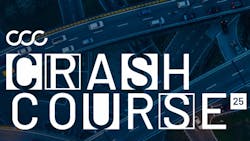CCC Report Finds Increase in Parts Demand and Cost

CCC Intelligent Solutions released its Q1 2025 Crash Course report, which focuses on how the evolution of the U.S. car parc toward longer vehicle ownership and more complex vehicles contribute to growing repair costs.
The report, based on data from 300 million claims-related transactions and millions of bodily injury and personal injury protection (PIP)/medical payments (MedPay) casualty claims, highlights how increases in vehicle cost and interest rates are causing longer vehicle ownership. The U.S. vehicle market transformations are driven by a combination of trends, said Kyle Krumlauf, director of industry analytics at CCC and co-author of Crash Course, in a news release.
“We're seeing the convergence of several structural shifts including longer vehicle life, increasingly complex and tech-driven repairs, cost inflation, changing ownership models and rising consumer expectations,” he said. “It's this intersection — not any single trend — that marks a true inflection point for the auto claims and repair economy. Our Q1 report helps the industry understand these forces and plan accordingly.”
The report examines how more complex repairs are driven by the increasing complexity of vehicles, particularly EVs and hybrids. Advanced driver assistance systems are becoming more common, adding additional calibration and diagnostic work. Repair shops need a wider variety of parts on hand to finish complex jobs in a timely manner. The uncertainty surrounding U.S. tariffs on automobile parts adds additional financial pressures shops might have to absorb.
Key findings of the report include:
- Average age of vehicles on the road increases: The average age of vehicles on the road in 2024 grew to 12.7 years. In 2014, it was 11.4 and it is projected to reach 13 years by 2026. Shifts in consumer behavior and economic conditions contributing to vehicle age include longer vehicle ownership, longer loan terms, rising vehicle costs, higher interest rates, supply chain disruptions, and inflation and cost of living pressures.
- EV adoption slows: New EV sales continued to set record levels, but at a lower growth rate. It increased by 7.4% in 2024. In prior years, new EV sales increased by 90% in 2021, 66% in 2022, and 50% in 2023, respectively.
- Consumers lean toward larger vehicles: SUVs and crossover utility vehicles now represent over 50% of the car parc for model years 2020 and newer – up from about 35% in 2014. Traditional passenger cars declined to less than 20% in recent model years.
- More parts needed, but fewer available: The average number of parts used in EV, hybrid, and ICE vehicle repairs decreased, but repair shops need wider varieties of parts to meet different vehicle needs. This can lead to longer repair times, particularly for older or more specialized vehicles.
- ADAS increases diagnostic frequency and cost: The Highway Loss Data Institute estimates that by 2028, six ADAS systems will be present in half or more registered vehicles. ADAS-equipped vehicles require more frequent calibration and diagnostic procedures, which increase repair costs. Direct repair programs scan almost 90% of vehicles aged three years or newer. Scan fees are slightly higher than the industry average for EVs and higher for hybrids. Hybrids are also more complex; hybrid estimates include calibrations almost 10 percentage points higher than the industry and over 7 points higher than EVs.
- Total cost of repair trends: Data compiled thus far for the average total cost of repair for 2024 is expected to result in a 3-4% increase, which would be the lowest increase since 2017. CCC said increases in total losses and vehicle age help mitigate rising repair costs. However, labor rates, diagnostics, and part prices are underlying factors that could contribute to cost increases going forward. Part prices are a particular concern as the U.S. implements automotive part tariffs.
CCC Intelligent Solutions Inc. plans to release the Crash Course report quarterly in 2025 to provide more frequent updates on key trends and insights. The Q1 2025 report is the 33rd edition of Crash Course. It can be downloaded from their website.
About the Author
FenderBender Staff Reporters
The FenderBender staff reporters have nearly four decades of combined journalism and collision repair experience.